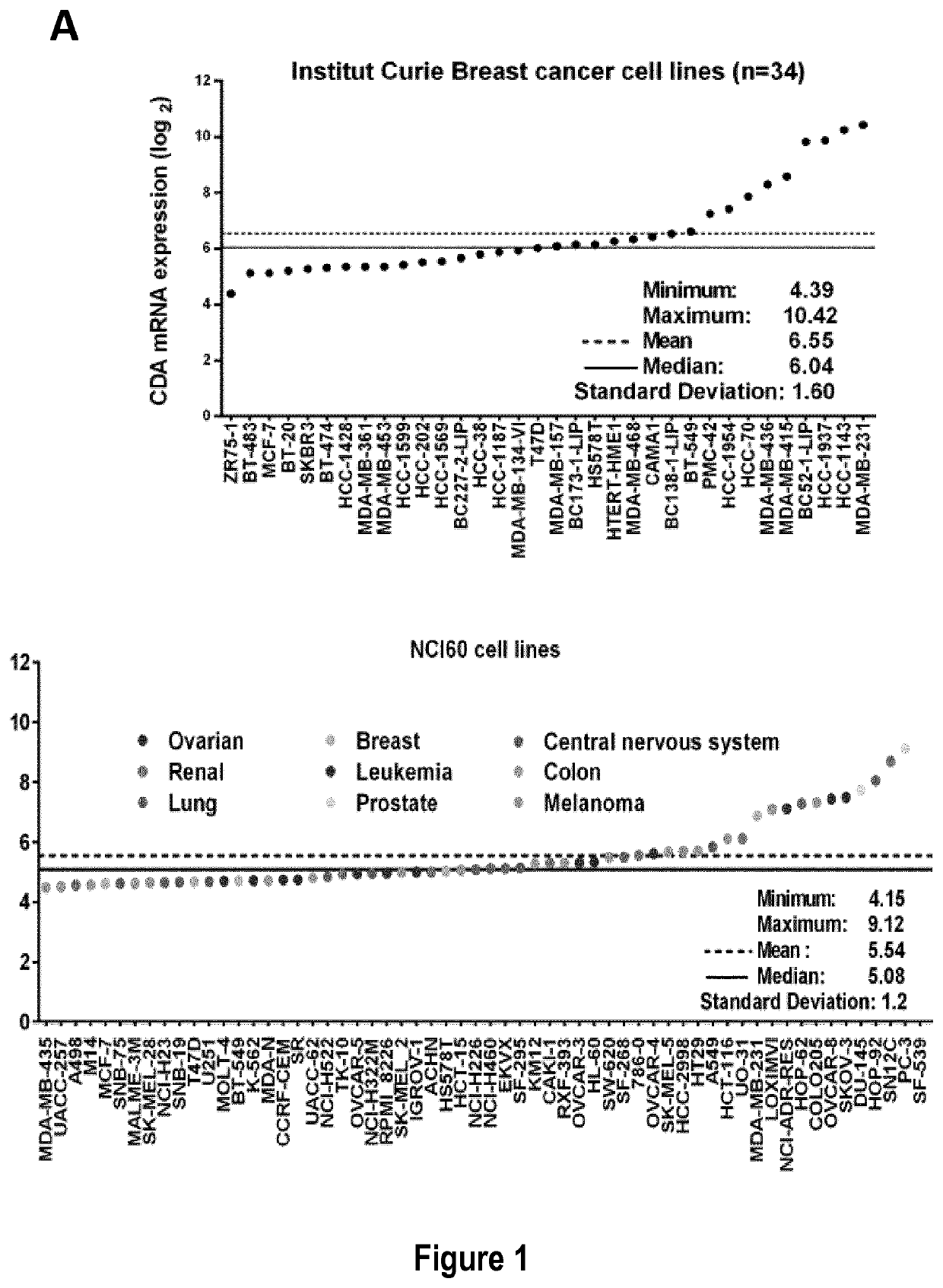Cytidine deaminase expression level in cancer as a new therapeutic target
a technology of cytidine deaminase and cancer, applied in the field of medicine, can solve the problems of poor prognosis of many cancers, and achieve the effect of reducing the proliferation rate of normal cells
- Summary
- Abstract
- Description
- Claims
- Application Information
AI Technical Summary
Benefits of technology
Problems solved by technology
Method used
Image
Examples
example 1
Materials and Methods
[0211]Cell Culture and Treatments
[0212]The inventors used 33 cancer cell lines in this study (cf. Table 5): 19 breast cancer cell lines from the Translational Research Department of the Curie Institute (ZR75-1, T47D, HCC-1428, BT-474, MCF-7, MDA-MB-361, MDA-MB-468, MDA-MB-231, MDA-MB-436, HCC-38, HCC-70, HCC-1187, HCC-1937, HCC-1143, BT-20, BT-549, HCC-1954, SKBR-3, HS578T) and two nonmalignant breast cell lines (MCF-12A and 184B5), four lung cancer cell lines (H522, H23, HOP-92, HOP-62), three ovarian cancer cell lines (IGROV-1 SKOV-3 and OVCAR-8) from the NCI, one melanoma cell line (A2058) from Dr. Stephan Vagner's laboratory (UMR3348 CNRS, Curie Institute), and two cervical cancer cell lines (HeLa-Ctrl and HeLa-shCDA) and two Bloom syndrome cell lines (BS-Ctrl and BS-CDA), previously described (cf. Reference 5).
[0213]All cells were routinely checked for the absence of mycoplasma and were maintained in the recommended media (cf. Table 5) before the extraction...
example 2
[0263]Materials and Methods
[0264]Cell Culture and Treatments
[0265]5 cancer cell lines were used in this study (cf. table 5): 3 breast cancer cell lines from the Translational Research Department of the Curie Institute (MCF-7, MDA-MB-468 and MDA-MB-231) and two cervical cancer cell lines (HeLa-Ctrl and HeLa-shCDA).
[0266]All cells were routinely checked for the absence of mycoplasma and were maintained in the recommended media (cf. table 5).
[0267]Cell viability was carried out with 3-(4,5-dimethyl-2-thiazolyl)-2,5 diphenyl-2H-tetrazolium bromide (MTT-Life Technologies) in 96-well microplates. The cell viability was assessed after dasatinib (Sigma Aldrich) treatment during 72 h by plating MCF-7, MDA-MB-468 and MDA-MB-231 cells at densities of 3000 cells / well, and HeLa-Ctrl and HeLa-shCDA at 1500 cells.
[0268]Results
[0269]The CellMiner web tool (33) can be used to assess the correlation between gene expression and drug sensitivity / resistance. The inventors searched for drugs with antipro...
example 3
[0273]The results presented in this example constitute a new analysis of in-vivo experiments already presented in Terzuol et al. (Cancer Res., 2010, 70: 6837-48) and Stark et al. (PloS One, 2013, 8:e74525). In particular, the FIG. 8 is FIG. 6A of Terzuol et al. and FIG. 9 is FIG. 4A-B of Stark et al.
[0274]Materials and Methods
[0275]MCF7 Xenograft (Directly From Terzuol et al.)
[0276]Studies were conducted in an AAALAC-accredited facility with an approved animal protocol. MCF-7 (1×107) were injected subcutaneously (s.c.) into the flank of female athymic nude (NCr / nu) mice (Animal Production Area, NCI-Frederick). Beta-estradiol cypionate (3 mg / kg) was administered intramuscularly every 7 days. Tumor size was determined by collecting length and width measurements and calculating the tumor weight (mg) as [tumor length×(tumor width)2] / 2, where the tumor length is the longest dimension (mm) and the tumor width is the narrowest dimension (mm). AF (saline / 0.05% Tween 80) was dosed i.p. Five ...
PUM
| Property | Measurement | Unit |
|---|---|---|
| pH | aaaaa | aaaaa |
| thick | aaaaa | aaaaa |
| distance | aaaaa | aaaaa |
Abstract
Description
Claims
Application Information
 Login to View More
Login to View More - R&D
- Intellectual Property
- Life Sciences
- Materials
- Tech Scout
- Unparalleled Data Quality
- Higher Quality Content
- 60% Fewer Hallucinations
Browse by: Latest US Patents, China's latest patents, Technical Efficacy Thesaurus, Application Domain, Technology Topic, Popular Technical Reports.
© 2025 PatSnap. All rights reserved.Legal|Privacy policy|Modern Slavery Act Transparency Statement|Sitemap|About US| Contact US: help@patsnap.com



